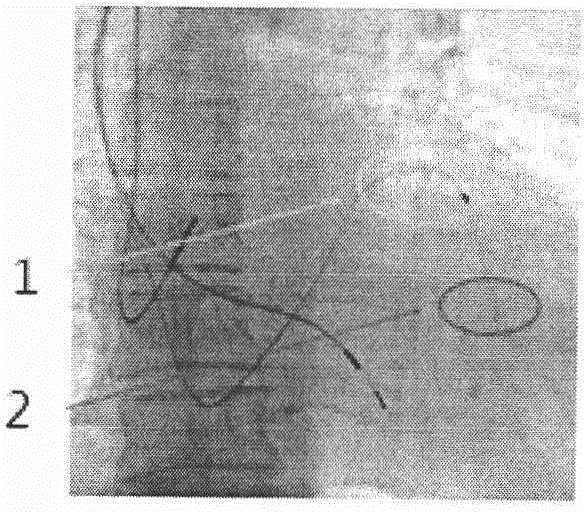Method for retaining percutaneous transluminal coronary angioplasty guide wire left ventricular pacing
A technique of coronary artery and endoplasty, applied in surgery, electrotherapy, medical science, etc., can solve problems such as treatment failure, and achieve the effect of no complications, large test fluctuations, and good treatment effect
- Summary
- Abstract
- Description
- Claims
- Application Information
AI Technical Summary
Problems solved by technology
Method used
Image
Examples
Embodiment 1
[0012] A 77-year-old male patient suffered from intermittent chest tightness, shortness of breath, and palpitation for 4 years, and was admitted to the hospital in January after aggravation. Diagnosis: dilated cardiomyopathy, cardiac function grade IV. After being given optimized drug therapy after admission, a Medtronic 8042 three-chamber pacemaker was implanted. During the implantation process, the 4193-type left ventricular electrode entered multiple coronary veins, and the pacing was poor. However, the extended pacing in the lateral cardiac vein with the percutaneous transluminal coronary angioplasty guidewire obtained a satisfactory threshold (1.5V), but the impedance The lower level was only 306ohms, and the muscle beating at the place where the pacemaker was implanted in the patient was obvious. After changing the left ventricular electrode pacing mode from Unipolar to LVtip / RVring mode, the muscle beating disappeared. Follow-up 1 month later, no adverse events occurred....
Embodiment 2
[0014] A 77-year-old male patient suffered from intermittent chest tightness, shortness of breath, and palpitation for 4 years. He was admitted to the hospital after aggravation in January. The electrocardiogram showed: sinus rhythm, QRS wave duration of 167ms, and complete left bundle branch block. Cardiac color Doppler: dilated cardiomyopathy, left ventricular ejection fraction (LVEF) measured by biplane method was 0.12, left ventricular end-diastolic diameter (LVEDD) was 84mm, left ventricular posterior and inferior motion delay, (Ts-SD-12 ): 94ms. Clinical diagnosis: dilated cardiomyopathy, cardiac function grade IV. After being given optimized drug therapy after admission, a Medtronic 8042 three-chamber pacemaker was implanted. During the implantation process, third-degree atrioventricular block occurred when the coronary sinus guiding catheter was placed, and the right ventricular electrode was implanted immediately for pacing. During the placement of the 4193 type lef...
PUM
 Login to view more
Login to view more Abstract
Description
Claims
Application Information
 Login to view more
Login to view more - R&D Engineer
- R&D Manager
- IP Professional
- Industry Leading Data Capabilities
- Powerful AI technology
- Patent DNA Extraction
Browse by: Latest US Patents, China's latest patents, Technical Efficacy Thesaurus, Application Domain, Technology Topic.
© 2024 PatSnap. All rights reserved.Legal|Privacy policy|Modern Slavery Act Transparency Statement|Sitemap

